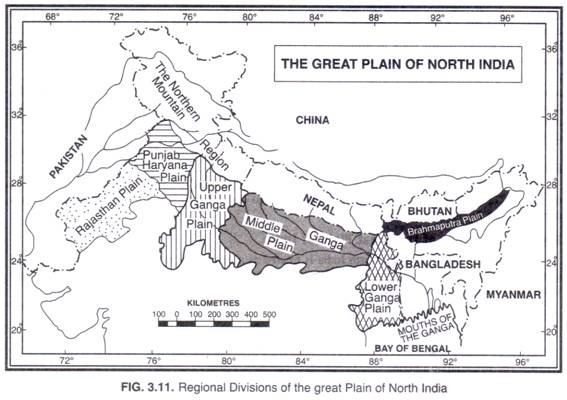Here is your paragraph on the Great Plain of North India !
The western extremity of the Great Plain of India consists of the Thar or the Great Indian Desert which covers western Rajasthan and the adjoining parts of Pakistan.
The desert is about 650 km long and 250-300 km wide. Its total area is about 2.0 lakh sq km out of which 1.75 lakh sq km lies in India.
About two thirds of the Indian desert lies in Rajasthan, west of the Aravali Range, and the remaining one third is in the neighbouring states of Haryana, Punjab and Gujarat. Recently, some geomorphic studies by using remote sensing techniques in conjunction with ground truth were undertaken by the Central Arid Zone Research Institute, Jodhpur.
ADVERTISEMENTS:
This vast desert is an undulating plain whose average elevation is about 325 m above mean sea level. It descends to about 150 m above mean sea level near the Indo-Pak border as well as towards the Indus Valley and the Rann of Kuchchh.
The desert proper is called Marusthali and accounts for greater part of the Marwar plain. The average elevation of the Marusthali is 200-250 m above sea level. It has a vast stretch of sand with a few outcrops of bedrock of gneisses, schists and granites which proves that geologically it is a part of the Peninsular Plateau and it is only at the surface that it looks like an aggradational plain. In general, the eastern part of the Marusthali is rocky while its western part is covered by shifting sand dunes locally known as dhrian.
ADVERTISEMENTS:
The eastern part of the Thar Desert, upto the Aravali Range is a semi-arid plain which is known as the Rajasthan Bagar. It runs in a north-east to south-west direction from the edge of the Aravalli in the east to the 25 cm isohyet (line joining places of equal rainfall) in the west.
It is drained by a number of short seasonal streams originating from the Aravali and supports agriculture in some patches of fertile tracts called rohi. Even the important river, the Luni, is a seasonal stream which flows towards the south-west to the Rann of Kuchchh. The tract north of the Luni is known as thali or sandy plain.
The LANDSAT black and white products have been used to study the geomorphological characteristics of this Great Desert including its sand dunes. Based on the morphological, spatial and spectral characteristics, six types of sand dunes, viz., obstacle, parabolic, longitudinal, transverse, barchan and shrub-coppice have been identified in this desert. The mean height of the dunes varies from 8 m in Jaipur and Sikar districts to 30 m in Barmer district. The length of the dunes also varies greatly and some may be 5-10 km long.
North of the Luni basin, there is a large area of inland drainage on the eastern edge of the Thar Desert having several saline lakes. They are a great source of common salt and many other salts. The Sambhar, the Didwana, The Degana, the Kuchaman, the Sargol and the Khatu are some of the important lakes.
The largest and the most outstanding is the Sambhar lake about 65 km west of Jaipur. Situated at an altitude of about 360 m in the Aravali terrain, this lake is about 30 km long with an average width of 3-8 km. It occupies an area of about 225 sq km during the rainy season but shrinks considerably in dry season.
